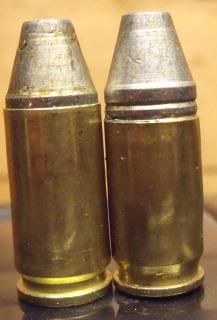A Cautionary Tale about brass sorting
Posted: Wed Sep 07, 2011 12:26 am
Once upon a time, an enthusiastic new reloader had so much fun working up his .45 ACP reloads that he decided to expand his operations. He knew his wife would plow through copious amounts of 9mm rounds, so he prepared to load those cases, too. He'd scrounge for brass at the local range and carefully clean and sort the calibers when he got home.
One time, he accidentally loaded a .380 ACP case as a 9mm round! He didn't catch it in the sorting phase, nor in the decapping/resizing operation, nor in the loading, crimping, or final inspection phases of the process. Not even when he marked the cases with a Sharpie did he see the headstamp declaring that it didn't belong with the others.
It wasn't until he ran the cases through the tumbler again and started decapping/resizing the re-recycled brass that he noticed a .380 ACP case with the telltale mark of a red Sharpie. He almost needed to sit down as his heart did a little skip and jump. as he wondered what could have been.
The End
********
I'm not exactly sure how this round made it through the firing process, but I know how it slipped through the earlier steps (except for the loading/crimping phase - that still befuddles me). Looking at several hundred cases at a time can give one a sort of "highway hypnosis" and those 2mm of case length suddenly vanish.
I've made it a point to look at headstamps only now on "found brass" as a means of making sure this doesn't happen again.
I guess that since the bullet stopped at it's 'normal' place during loading (and wound up being the same OAL as all the other rounds) that this is the reason there wasn't a pressure issue. The case had the same internal volume as a 9x19 case, there just wasn't as much brass holding the bullet in place.
Since my wife and father-in-law were doing about 95% of the shooting from that batch of ammo, I have no way of telling how differently it performed that any of the other rounds. The gun is a Ruger SR9c, and I guess extractor tension is what held the round in place for the striker.
How do y'all make sure that you don't do something like this? There's enough variation between .45 and .40, and .40 and 9mm, but 9mm and .380 are awful close and I don't want to make this mistake again. I suppose I'll also sort smaller batches of brass at a time, too, to avoid a repeat.
One time, he accidentally loaded a .380 ACP case as a 9mm round! He didn't catch it in the sorting phase, nor in the decapping/resizing operation, nor in the loading, crimping, or final inspection phases of the process. Not even when he marked the cases with a Sharpie did he see the headstamp declaring that it didn't belong with the others.
It wasn't until he ran the cases through the tumbler again and started decapping/resizing the re-recycled brass that he noticed a .380 ACP case with the telltale mark of a red Sharpie. He almost needed to sit down as his heart did a little skip and jump. as he wondered what could have been.
The End
********
I'm not exactly sure how this round made it through the firing process, but I know how it slipped through the earlier steps (except for the loading/crimping phase - that still befuddles me). Looking at several hundred cases at a time can give one a sort of "highway hypnosis" and those 2mm of case length suddenly vanish.
I've made it a point to look at headstamps only now on "found brass" as a means of making sure this doesn't happen again.
I guess that since the bullet stopped at it's 'normal' place during loading (and wound up being the same OAL as all the other rounds) that this is the reason there wasn't a pressure issue. The case had the same internal volume as a 9x19 case, there just wasn't as much brass holding the bullet in place.
Since my wife and father-in-law were doing about 95% of the shooting from that batch of ammo, I have no way of telling how differently it performed that any of the other rounds. The gun is a Ruger SR9c, and I guess extractor tension is what held the round in place for the striker.
How do y'all make sure that you don't do something like this? There's enough variation between .45 and .40, and .40 and 9mm, but 9mm and .380 are awful close and I don't want to make this mistake again. I suppose I'll also sort smaller batches of brass at a time, too, to avoid a repeat.
